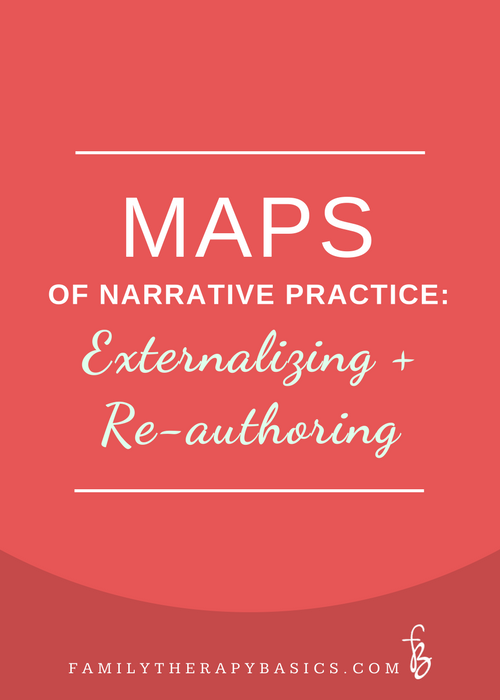In his last book on narrative practice, Maps of Narrative Practice (2007), Michael White presents maps as "constructions that can be referred to for guidance on our journeys--in this case, on our journeys with the people who consult us about the predicaments and problems of their lives” (p. 5).
The maps of narrative practice offer therapists a view of the therapeutic landscape--what has been traveled with clients and what is yet to be explored. Like any theory, remembering the already traveled paths will reveal the possibilities for where to go next.
In Maps, White throughly explains the structure of externalizing conversations, re-authoring conversations, re-membering conversations, definitional ceremonies, conversations that highlight unique outcomes, and scaffolding conversations. In this post, I offer an overview of the first two conversations: Externalizing and re-authoring.
Externalizing Conversations
Clients often participate in therapy with a pre-established notion that problems are linked to their personalities. Through externalizing conversations, clients begin to recognize that problems are separate from them, which frees them to see new options for living with problems, or, perhaps, even living problem-free.
Therapist Posture
White describes the therapist’s posture in externalizing conversations as one of an “investigative reporter,” working to discover and reveal “abuses of power and privilege” affecting the life of the client (2007, p. 27).
The maps of externalizing conversations also include four categories of inquiry:
1 | Negotiating a particular, experience-near definition of the problem
Through these conversations, grand and all-powerful problem definitions are relinquished by clients in order to make room for specific, nuanced understandings of the problem.
2 | Mapping the effect of the problem
In this stage, therapists map the problem’s influence and presence in the life of the client, including the client’s environments, relationships, and thoughts.
3 | Evaluating the effects of the problem’s activities
Through evaluation, therapists facilitate conversations that explore the problem’s actions in clients' lives, and the effects of these actions. Some examples of evaluative questions, from Maps of Narrative Practice (p. 44):
Are these activities okay with you?
How do you feel about these developments?
How are these developments for you?
Where do you stand on these outcomes?
What is your position on what is unfolding here?
Is this development positive or negative--or both, or neither, or something in between?
If this were served up to you as a fate in life, would you have any questions about it?
4 | Justifying the evaluation
During this stage of inquiry, therapists explore the client’s orientation toward the developments discovered in the previous stage. For example, therapists may ask, “Why is this development okay/not okay for you?" Or, alternatively, therapists invite stories:
“Would you tell me a story about your life that would help me understand why you would take this position on this development?”
Or, ask for a story with a circular question:
“What stories about your history might your father share to throw some light on why you are so unhappy about this development? (p. 48)
Re-Authoring Conversations
The process of clients re-authoring their lives involves noticing the “quiet,” unnoticed stories that are able to support clients’ budding identities as they separate themselves from their problems. These “quiet” stories are often referred to in narrative practice as “unique outcomes,” or “exceptions.”
“Effective therapy is about engaging people in the re-authoring of the compelling plights of their lives in ways that arouse curiosity about human possibility and in ways that invoke the play of imaginations” --Michael White
Identities and Action
The foundation for re-authoring conversations includes both the landscape of identity and the landscape of action. These landscapes are concurrently explored with the purpose of allowing exceptions to take their place in the stories of clients' lives.
Landscape of Identity and Landscape of Action Questions
The landscapes of re-authoring conversations are traveled through the use of questions that reveal assumed "internal states" (characteristics, positive or negative, believed to be personality traits, or somehow part of the "self") as "intentional states"--the result of actions and consistent pursuits.
Landscape of identity questions require a “subjunctive," or tentative stance by therapists; this stance leaves clients room for interpretation and multiple possibilities. For example, the question: What might this experience mean about your wife’s desires for your relationship?
Landscape of action questions tie new stories about meaning and motivation to concrete actions that give context to the developing identity. For example, the question: What story can you tell me about a time when your wife’s actions showed these desires?
In Conclusion
For more information on the philosophical foundations for externalizing and re-authoring conversations, as well as the conversational maps developed by Michael White, see the book, Maps of Narrative Practice.
For more information on narrative practice, see:
White, M., & Epston, D. (1990). Narrative means to therapeutic ends. New York, NY: Norton.
White, M. (2007). Maps of narrative practice. New York, NY: Norton.
Stay tuned to the blog for more on the narrative practice series.
Let's Chat!
Let me know in the comments below:
How do you incorporate externalizing or re-authoring conversations in your work?













